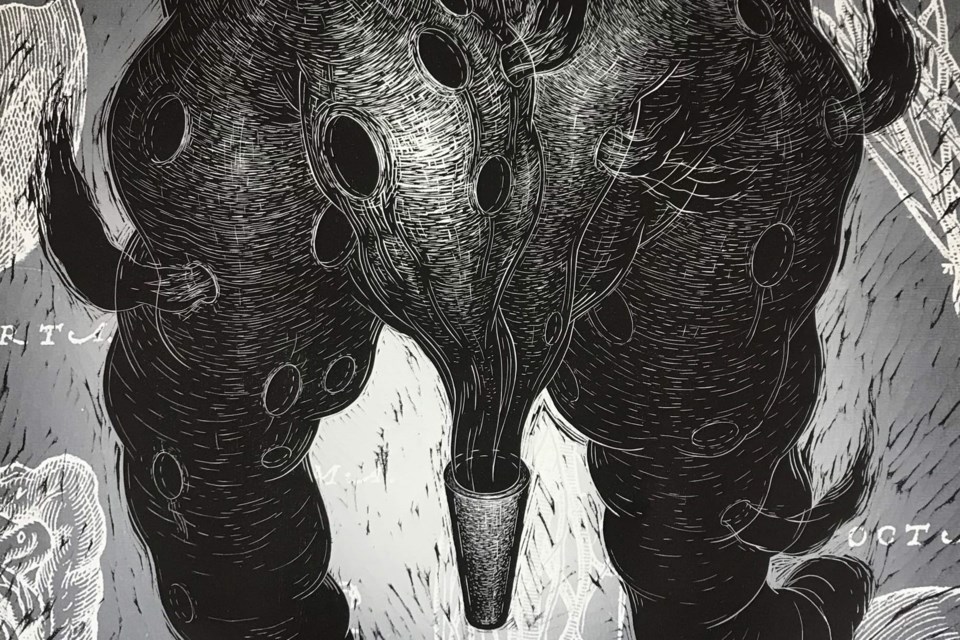There is a lot of bad information out there in the age of the COVID-19 pandemic and it’s being spread farther and farther around. Two brothers, both respected in their respective fields of art and law, have teamed up to fight back.
“The info-demic, as it's been called, is acute,” explained University of Alberta health law professor Timothy Caulfield.
“There's misinformation about the pandemic absolutely everywhere and on every topic imaginable. The spread of misinformation has become a serious, serious policy and communication challenge. It is really harmful. There have been deaths associated with it.”
Caulfield is working arm-in-arm with his brother, visual artist Sean Caulfield, for a joint project that combines vaguely dysmorphic pseudo-anatomical illustrations as icebreakers into a larger conversation about science, truth and the importance of a well-placed pause.
“It seemed like a pretty natural fit to a collaboration that's been going on for quite some time,” Sean said, mentioning that the artwork he is offering to this collaboration comes from his contributions to Dyscorpia 2.1: The Body and technology in the time of COVID-19.
The two have collaborated numerously over the years on projects with subjects such as vaccines and stem cells. When the coronavirus took the world’s attention, Timothy was soon involved in a campaign called ‘Check First. Share After’ through MediaSmarts to help stop the spread of misinformation in what he calls a “chaotic information environment.”
“Research tells us that if the information environment is really chaotic, people may be less likely to follow advice. It might have an adverse impact on the degree of trust individuals have in our public health agency and other important institutions. It can do a lot of harm,” Timothy said. “We're hoping that using art can nudge us in the other direction.”
Art is not just thought-provoking in its own way, but it can engage the public on issues in ways that science and statistics don’t. Art, at least, helps people to stop for the moment to look at it. That’s part of the ‘pause’ effect they’re aiming for.
“There's evidence that suggests that that can work. In addition to that, we want to get people just to think about accuracy. There's really interesting research. In fact, one of our collaborators on our projects has done empirical research that shows if you just get people to pause to think before they share, you can have an impact on the spread of misinformation,” Timothy continued.
Sean explained his art stems from his longstanding interest in the history of anatomical illustration. For this project, he would start his images by appropriating older anatomical images and then drawing overtop of them.
“For me, one of the things that's interesting there is some of those older anatomical images are about the emergence of empirical science and thinking about the body from that lens. Over top of that, I’m inventing things,” he said. “I suppose I'm partly thinking about how we feel about our bodies. On the one hand, there's a scientific lens and (on) the other hand is an emotional lens that isn't rational in a sense. When you think about COVID ... there's a lot of anxiety and uncertainty. Maybe the art is one way to speak to that tension.”
The art being used for this campaign comes complete with special hashtags such as #ThinkAccuracy, #ScienceBased or #SuperSpreader, which were designed by U of A graphic artist and design professor Sue Colberg.
The art is the centerpiece of the brothers’ campaign called Coronavirus Outbreak: Mapping and Countering Misinformation. They both spoke of how people still want to help and they still want to be accurate even when they are sharing erroneous information.
"This is part of the challenge. For sure, people have shared things with me. They're trying to help. In a way, that's what I'm hoping my art can do in collaboration with my brother. When an image like one of mine appears, hopefully it's a complex read. It's not a quick read. It's a slower read. I hope that idea of a more nuanced, complex experience can carry over to other parts of our lives," Sean said.




